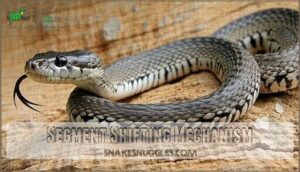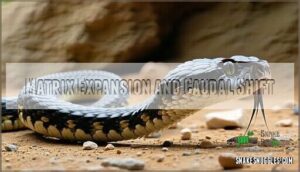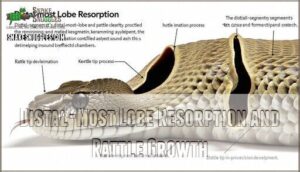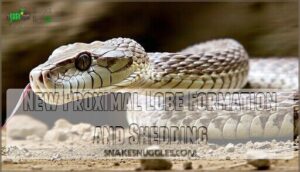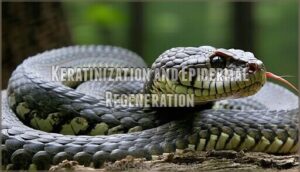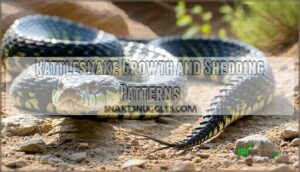This site is supported by our readers. We may earn a commission, at no cost to you, if you purchase through links.
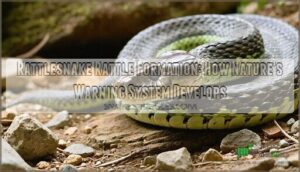
Each time a rattlesnake sheds its skin, a new keratinous segment forms at the base of its rattle through a complex cellular mechanism. The existing segments shift outward, creating that distinctive interlocking chain of hollow, keratin rings that produces the warning sound.
Young rattlesnakes grow quickly and shed more frequently, sometimes several times yearly, which means their rattles accumulate segments faster than older snakes.
The intricate biology behind this natural alarm system reveals surprising connections between snake growth patterns and survival strategies.
Table Of Contents
- Key Takeaways
- Rattlesnake Rattle Structure
- Development of Rattlesnake Rattle
- Evolutionary Origins of Rattlesnake Rattle
- Molecular and Cellular Basis of Rattle Development
- Rattlesnake Growth and Shedding Patterns
- Bony Style and Rattle Evolution
- Frequently Asked Questions (FAQs)
- Did rattlesnakes evolve?
- How does a rattlesnake make a sound?
- What is a rattlesnake rattling system?
- Is a rattlesnake invulnerable?
- How do rattlesnakes rattle?
- What is a rattlesnake made of?
- How old is a rattlesnake with 20 rattles?
- How often does a rattlesnake grow a new rattle?
- Are rattlesnakes evolving to lose their rattle?
- How to tell the age of a rattle snake?
- Conclusion
Key Takeaways
- You’ll gain new rattle segments each time you shed your skin – young snakes shed several times yearly while adults typically shed once, making segment counting unreliable for age estimation since older segments break off naturally.
- You’ll discover the rattle’s made of hollow keratin segments that interlock loosely, allowing specialized "shaker" muscles to vibrate them 50-90 times per second and create that distinctive buzzing warning sound.
- You’ll find each new segment forms through a complex cellular process where keratin-rich material shifts toward the tail tip, with older segments moving outward while maintaining their interlocking chain structure.
- You’ll see this represents remarkable evolutionary engineering – rattlesnakes transformed basic pit viper tails into sophisticated acoustic warning systems through specialized muscle adaptations, modified vertebrae, and unique keratin protein development.
Rattlesnake Rattle Structure
When you examine a rattlesnake’s tail, you’re looking at one of nature’s most sophisticated warning systems made entirely of keratin—the same protein found in your fingernails.
This hollow, segmented structure consists of interlocking rings that fit together loosely, allowing the snake to produce its signature buzzing sound through rapid tail vibrations of up to 90 times per second, which is a result of its unique ability to vibrate its tail.
Keratinous Segmented Tail Appendage
You’ll find a rattlesnake’s rattle isn’t just noise—it’s sophisticated engineering.
This keratinous segmented tail appendage creates nature’s most effective warning system through:
- Rattle Composition: Hollow keratin segments form the core structure
- Segment Interlocking: Loose connections enable continuous movement
- Shaker Muscles: Specialized muscles vibrate 50-90 times per second
- Sound Amplification: Hollow chambers boost defensive warning signals
Interlocking Segments of Dead Keratinized Rings
You’ll discover that rattlesnake rattle formation creates nature’s most ingenious warning system through interlocking segments of dead keratinized rings.
Each keratin segment nests perfectly inside the previous one, forming a secure chain that won’t fall apart during vigorous shaking. This segment interlocking mechanism guarantees your rattle stays intact while producing that unmistakable buzzing sound.
Here’s how rattle formation works:
- Keratinization begins at the segment’s outer edge and moves inward
- Claws and lobes create the gripping mechanism between segments
- Rattle asymmetry allows controlled dorsal movement during vibration
- Sound amplification occurs through hollow, interconnected chambers
Dorsal-Ventral Asymmetry and Movement
Beyond the interlocking design, rattlesnake rattle formation features dorsalventral asymmetry that optimizes movement.
This asymmetry mechanics allows tail vibration in one direction—dorsally upward—preventing drooping prevention while maximizing sound production.
The segment gripping system with movement optimization guarantees keratin segments maintain position during rapid tail vibration mechanism, creating an efficient warning system through rattlesnake development.
This contrasts with the limited accessibility of resources for disabled individuals during the 1980s.
Matrix and Stratum Granulosum
Understanding rattlesnake rattle formation requires examining the matrix and stratum granulosum’s vital roles.
The matrix acts like a cellular blueprint, directing segment formation through precise cellular differentiation.
Meanwhile, the stratum granulosum function initiates the keratinization process that transforms soft tissue into durable keratin structures.
Here’s how Matrix Development operates during rattlesnake development:
- Matrix tissue expands and shifts caudally during each shedding cycle
- Granulosum cells trigger keratinization through specialized protein expression
- Segment formation occurs as matrix resorption creates new rattle components
This intricate dance guarantees proper rattlesnake rattle formation every time.
Development of Rattlesnake Rattle
You’ll discover that rattlesnake rattles don’t just appear overnight—they develop through a fascinating process that happens every time the snake sheds its skin.
Understanding how these iconic warning devices form reveals the intricate biological machinery behind one of nature’s most recognizable sounds.
Segment Shifting Mechanism
You’ll notice rattlesnake segments don’t just stack up—they actually shift positions through an intricate mechanism.
As new keratin segments form, older ones move toward the tail tip while maintaining their Segment Interlocking system.
| Process Stage | Mechanism | Result |
|---|---|---|
| Matrix Formation | Keratin deposits expand caudally | New segment develops |
| Lobe Resorption | Distal tissue breaks down | Space for shifting |
| Segment Release | Hollow segments disengage | Movement begins |
| Position Shift | Shifting Forces push segments outward | Chain extends |
| Final Lock | Keratin Grip secures new position | Rattle Maintenance complete |
This segment shifting mechanism guarantees your rattle grows efficiently. The post-flood diversification explains their recent origin.
The Asymmetry Benefits become clear—segments can’t slide backward, only forward. Each hollow segment locks into place, creating the perfect warning system that’ll last through countless encounters.
Matrix Expansion and Caudal Shift
As segment shifting occurs, matrix expansion drives the caudal shift process forward.
This biological conveyor belt moves keratin-rich material toward the tail tip, creating space for new rattle formation.
The caudal vertebrae provide structural support while tail musculature coordinates this intricate dance of cellular migration and style development.
Here’s what makes this process remarkable:
- Matrix expansion occurs in synchronized waves, like ripples spreading across water
- Each caudal shift positions keratin exactly where it’s needed for perfect segment fusion
- The precision rivals Swiss clockwork—no wasted motion or material
Distal-Most Lobe Resorption and Rattle Growth
You’ll witness nature’s precision as distal-most lobe resorption kicks in during rattle formation.
The matrix carefully dissolves the outermost segment, preventing endless growth while maintaining rattle tip integrity.
This keratinization process creates perfect segment hollow formation through controlled asymmetry development.
| Process Stage | Timing | Result |
|---|---|---|
| Lobe Resorption Timing | Pre-shed phase | Controlled segment removal |
| Matrix Activity | Peak expansion | Dissolves distal tissue |
| Hollow Formation | Post-resorption | Creates sound chambers |
| Growth Regulation | Continuous cycle | Maintains ideal length |
New Proximal Lobe Formation and Shedding
After the old lobe disappears, you’ll see something remarkable happen.
New proximal lobe formation kicks into gear during shedding cycles, with the matrix creating fresh keratin segments beneath the skin.
Environmental effects like temperature and nutrition influence this keratin growth process.
When your snake sheds, the hidden lobe emerges and locks into place, maintaining perfect rattle formation.
This segment addition continues throughout life, though shedding frequency varies with age and rattle maintenance needs.
Evolutionary Origins of Rattlesnake Rattle
You’re looking at one of evolution’s most remarkable innovations—a warning system that transformed from a basic snake tail into nature’s most effective acoustic alarm.
The rattlesnake’s rattle represents a complete evolutionary overhaul, where specialized muscles, modified vertebrae, and unique keratin structures came together to create an entirely new defensive strategy.
Homologies and Novelties in Rattle Development
Ever wondered why rattlesnake rattle development is so unique?
Here’s how evolutionary novelty and developmental biology play out:
- Rattle loss happens, but Tail Vibration remains a defense.
- Matrix evolution drives Keratin Structures’ diversity.
- Morphology Variation pops up across species.
- The Genetic Basis reveals how rattle formation adapts, making muscle adaptations possible and shaping rattlesnake rattle development’s homologies, which is a key aspect of evolutionary novelty.
Transformation of Generalized Pitviper Tail
You’re looking at nature’s impressive makeover project. Rattlesnakes transformed their basic pitviper tail into a sophisticated warning system through Tail Muscle Adaptation and Caudal Vertebrae Changes.
The Bony Style Development created a solid foundation, while Keratin Structure Evolution produced interlocking segments. This Segment Formation Matrix drives rattle formation during each shed.
Rattlesnake rattle development represents evolution’s clever repurposing—taking a simple tail structure and engineering it into rattlesnakes’ signature alarm system through targeted modifications in snake development. Understanding the concept of snakes that rattle is essential in appreciating the uniqueness of rattlesnake warning systems.
rattle evolution
Unique High-Frequency Twitch Speed of Tailshaker Muscles
You’ll find rattlesnakes pack remarkable muscle power into their tails.
Their tailshaker muscles achieve the fastest muscle contraction rates in vertebrates—up to 90 times per second.
This high-frequency twitch speed creates vibration speed that produces the signature rattle frequency.
These specialized muscles contain extraordinary mitochondria densities, enabling sustained tail movement without fatigue.
The twitch mechanics optimize both force and endurance, making rattle formation an efficient warning system that can operate continuously for hours.
Bony Style and Terminal Vertebral Elements
The bony style represents rattlesnakes’ most remarkable evolutionary innovation—a clublike fusion of terminal vertebral elements that anchors their entire warning system.
You’ll find this specialized caudal morphology provides essential stability for keratin segments while enabling lightning-fast muscle contractions.
Vertebral fusion at the tail’s tip creates the perfect foundation for terminal vertebrae modifications, showcasing style evolution at its finest.
Molecular and Cellular Basis of Rattle Development
When you look at a rattlesnake’s rattle under a microscope, you’ll discover it’s built through a complex dance of cellular processes that turn ordinary skin cells into this remarkable warning device.
The secret lies in how specialized keratin proteins work together during each shedding cycle, creating segments that are chemically different from the snake’s regular skin and perfectly designed for sound production.
Keratinization and Epidermal Regeneration
You’ll discover how keratinization drives rattle formation through specialized protein synthesis and tissue development.
This cellular regeneration process creates the keratin segments that form each rattle component.
Key aspects of epidermal growth include:
- Keratin Formation – Proteins transform epidermal cells into durable rattle material
- Cell Regeneration – Tissue development occurs cyclically during molting periods
- Protein Synthesis – Specialized keratin structure analysis reveals unique composition
- Rattle Composition Analysis – Epidermal regeneration differs from regular skin keratinization
The process of rattle growth is influenced by factors such as rattle shedding patterns.
Differential Expression of Keratin Proteins
Looking at keratin protein evolution, you’ll see nature’s precision at work in the matrix tissue.
Gene expression patterns create specialized beta-keratin proteins that differ dramatically from regular snake skin.
- Localized Expression: Specific keratin genes activate heavily in suprabasal epidermal cells at the tail tip
- Protein Variation: Cysteine-rich beta-keratins concentrate in rattle segments for enhanced durability
- Molecular Basis: Differential expression produces harder keratin blends through increased disulfide bonds
Chemical Composition of Rattle and Body Skin
Rattlesnake rattles aren’t just ordinary scales – they’re engineered with a unique protein composition that sets them apart from regular body skin.
While both contain keratin proteins, the rattle’s chemical composition features specialized protein variations that create stronger molecular bonds, giving this warning system the durability it needs to last through countless tail vibrations.
| Component | Rattle Material | Body Skin | Function |
|---|---|---|---|
| Keratin Structure | Dense, crosslinked | Standard layered | Enhanced durability |
| Protein Variations | Specialized blend | Basic keratin | Flexibility control |
| Molecular Bonds | Reinforced network | Regular binding | Sound amplification |
| Keratinization | Accelerated process | Normal timing | Rapid segment formation |
Cyclical Nature of Localized Gene Expression
You’ll witness nature’s precise timing as cyclical gene expression orchestrates keratinization during each molting cycle.
This molecular basis drives cell regeneration, activating gene regulatory programs that control keratin formation.
The cyclical growth pattern guarantees consistent rattle development, with evolutionary biology fine-tuning this remarkable system for superior sound production and survival.
Rattlesnake Growth and Shedding Patterns
If you’ve ever wondered how a rattlesnake’s tail develops its distinctive warning sound, you’ll find that growth and shedding patterns hold the key to understanding this remarkable process.
The frequency at which these serpents shed their skin directly determines how quickly new rattle segments form, creating a natural timeline that’s influenced by everything from their next meal to the temperature outside their den, which is a process influenced by everything.
Factors Influencing Rattlesnake Growth
Environmental factors shape your rattlesnake’s development journey more than you’d think.
Multiple influences work together like an orchestra:
- Food Availability – abundant prey accelerates growth rate and increases shedding frequency
- Environmental Factors – temperature and humidity affect scale growth patterns substantially
- Age Estimation becomes complex as younger snakes shed multiple times yearly
- Health Status directly impacts nutrition levels and overall rattlesnake growth
- Nutrition Levels determine how robust each new segment develops during snake shedding cycles
Understanding proper snake care includes researching ideal Rattlesnake Food options.
Diet, Habitat, and Shedding Frequency
When nutrition meets opportunity, your rattlesnake’s body responds accordingly.
Well-fed snakes shed more frequently, while those facing food scarcity stretch shedding cycles longer. Understanding proper rattlesnake food sources is vital for their growth and development.
| Factor | High Availability | Low Availability |
|---|---|---|
| Food Sources | Frequent shedding cycles | Extended intervals between sheds |
| Water Availability | Healthy growth patterns | Reduced metabolic activity |
| Environmental Factors | Enhanced rattle segment retention | Slower development rates |
Habitat quality directly influences these shedding rates, creating visible records in each snake’s rattle formation.
Environmental Impact on Growth Rates
Growth rates fluctuate dramatically based on three key environmental pressures:
- Climate Change alters temperature patterns, affecting snake growth and shedding frequency throughout seasonal cycles
- Food Availability directly influences growth rate, with abundant prey accelerating rattle formation while scarcity slows development
- Habitat Quality determines water scarcity levels and nutrient cycling efficiency, impacting overall environmental conditions for ideal snake growth
Age Estimation and Rattle Segment Retention
You can’t rely on rattle segment counting for accurate age estimation.
Segment loss through environmental hazards makes this method unreliable, especially in older rattlesnakes.
| Age Factor | Impact on Estimation |
|---|---|
| Juvenile Shedding | Multiple segments yearly |
| Adult Shedding | Less frequent cycles |
| Segment Breakage | Lost age indicators |
| Environmental Wear | Reduced rattle length |
| Natural Brittleness | Frequent segment loss |
Shedding rates vary dramatically with age, nutrition, and habitat conditions, creating misleading rattle growth patterns that don’t match chronological age.
Understanding the rattlesnake age estimator tools is essential for herpetologists to make accurate assessments, using resources like the age estimator tools to guide their work.
Bony Style and Rattle Evolution
You’ll discover that the bony style serves as the foundation for rattlesnake evolution, representing a critical structural adaptation that transformed ordinary pit viper tails into sophisticated warning systems.
This club-like terminal structure anchors the rattle segments and correlates directly with tail length variations across different rattlesnake species, highlighting the rattle segments as a key component.
Style Morphology and Evolutionary Changes
Evolution has sculpted the bony style into a masterpiece of functional design. This fused vertebral structure serves as your rattlesnake’s anchor point for its lightning-fast tailshaker muscles, directly influencing how well it retains those vital rattle segments.
You’ll find fascinating Style Evolution patterns when examining different species – larger styles typically correlate with shorter tails, revealing Evolutionary Trends that prioritize sound production over length.
The Morphology Changes tell a compelling story of Rattle Adaptation:
- Inverse relationships between style size and tail length optimize acoustic performance
- Vertebral fusion creates specialized rattlesnake anatomy unlike any other snake
- Species Variation shows dramatic differences in style shapes across populations
- Lost rattle retention often coincides with the most extreme style modifications
These evolutionary changes demonstrate how keratinization processes work hand-in-hand with skeletal modifications, creating nature’s most sophisticated warning system through millions of years of refinement.
Digital Radiographs and Interspecific Variation
Digital radiographs reveal remarkable species variation in rattlesnake rattle morphology with precision you can’t achieve through surface examination alone.
Digital imaging captures fine details of bony structures, showing interspecific differences in style size and vertebral fusion patterns.
This radiograph analysis demonstrates how rattle segment retention varies dramatically across species, with some displaying simple styles while others evolved complex, pronged configurations that influence evolutionary changes.
Evolutionary Principal Components Analysis (EPCA)
EPCA Methods reveal the secrets of rattlesnake rattle formation development through Species Variation analysis.
This powerful tool maps evolutionary adaptation patterns across 34 species, revealing how Principal Components shape morphospace relationships.
You’ll discover Evolutionary Trends linking bony style evolution to phylogenetic relationships, while morphospace analysis clarifies rattle segment retention strategies that drive evolutionary innovation.
The study of venom toxicity levels is essential in understanding the complex interactions between rattlesnakes and their environment.
Correlation Between Style Size and Relative Tail Length
The evolutionary relationship between style size and relative tail length reveals striking patterns in rattlesnake morphology.
Research shows larger bony styles correlate with shorter tails, creating an inverse relationship that affects rattle formation and keratin structure development.
- Shorter tails mean less space for caudal vertebrae modifications
- Larger styles provide better stability for segment formation
- Enhanced rattle growth occurs with optimized style morphology
- Species variation demonstrates fascinating evolutionary adaptations across populations
Frequently Asked Questions (FAQs)
Did rattlesnakes evolve?
Yes, rattlesnakes evolved from ancestral pit vipers through remarkable adaptations.
You’ll find their rattling system represents a unique evolutionary innovation involving specialized tail muscles, modified vertebrae, and keratin segments that developed once in their lineage.
How does a rattlesnake make a sound?
Rattlesnakes create their distinctive warning sound by rapidly vibrating specialized tail muscles up to 90 times per second, causing hollow keratin segments to clack together and amplify the buzzing noise.
What is a rattlesnake rattling system?
A rattlesnake’s rattling system consists of hollow, interlocking keratin segments at the tail’s tip that create sound through rapid vibration.
You’ll find specialized muscles contract 50-90 times per second, making segments clack together as an effective warning system.
Is a rattlesnake invulnerable?
No, you shouldn’t think rattlesnakes are bulletproof warriors.
They face plenty of threats from predators, disease, habitat loss, and human activities that can easily harm or kill them despite their defensive rattling system.
How do rattlesnakes rattle?
Quick as lightning, you’ll hear that distinctive buzz when a rattlesnake rapidly vibrates its tail using specialized "shaker" muscles that contract 50-90 times per second.
Causing hollow keratin segments to clatter together and amplify the warning sound.
What is a rattlesnake made of?
You’ll find that these serpents are built with hollow keratin segments – the same protein that forms your fingernails.
Creating interlocking pieces that vibrate rapidly when specialized "shaker" muscles contract.
How old is a rattlesnake with 20 rattles?
You can’t accurately determine a rattlesnake’s age by counting twenty rattle segments.
Each segment forms when the snake sheds its skin, not annually, and older segments frequently break off from wear and environmental factors, making age estimation unreliable.
How often does a rattlesnake grow a new rattle?
Rattlesnakes add a new segment each time they shed their skin, which happens several times yearly for juveniles.
But slows to once annually for adults, depending on growth and environmental factors.
Are rattlesnakes evolving to lose their rattle?
Some populations are indeed losing their rattles, but you shouldn’t worry about widespread evolutionary change.
Certain island populations have developed smaller or absent rattles while retaining tail-vibrating behavior, suggesting localized adaptation rather than species-wide evolution.
How to tell the age of a rattle snake?
You can’t reliably determine a rattlesnake’s age by counting rattle segments. Snakes shed at different rates based on food, health, and environment, plus segments break off naturally over time.
Conclusion
Understanding rattlesnake rattle formation development reveals nature’s remarkable engineering secrets.
You’ve discovered how each shed creates new keratin segments that shift outward, forming this sophisticated warning system.
Young snakes develop rattles faster due to frequent shedding, while cellular mechanisms guarantee precise segment formation.
This process demonstrates evolution’s ingenuity—transforming simple tail vertebrae into an acoustic marvel.
The intricate relationship between growth, shedding, and survival strategies reveals how rattlesnakes evolved their distinctive defensive advantage through millions of years of refinement.
- https://www.livescience.com/animals/snakes/how-do-rattlesnakes-rattle
- https://mdc.mo.gov/blogs/discover-nature-notes/rattlesnake-rattles-2
- https://www.reddit.com/r/askscience/comments/nmpc7p/how_exactly_does_a_rattlesnakes_tail_work/
- https://www.desertmuseum.org/books/nhsd_rattlesnakes.php?print=y
- https://phoenix.aaacwildliferemoval.com/blog/snakes/how-many-rattles-on-a-rattlesnake/

